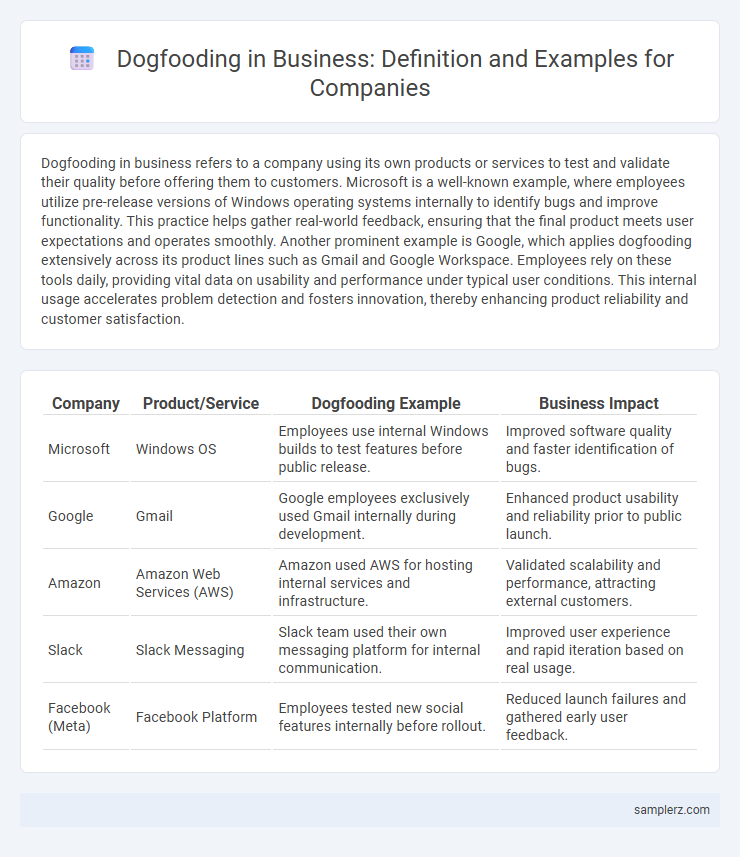Dogfooding in business refers to a company using its own products or services to test and validate their quality before offering them to customers. Microsoft is a well-known example, where employees utilize pre-release versions of Windows operating systems internally to identify bugs and improve functionality. This practice helps gather real-world feedback, ensuring that the final product meets user expectations and operates smoothly. Another prominent example is Google, which applies dogfooding extensively across its product lines such as Gmail and Google Workspace. Employees rely on these tools daily, providing vital data on usability and performance under typical user conditions. This internal usage accelerates problem detection and fosters innovation, thereby enhancing product reliability and customer satisfaction.
Table of Comparison
| Company | Product/Service | Dogfooding Example | Business Impact |
|---|---|---|---|
| Microsoft | Windows OS | Employees use internal Windows builds to test features before public release. | Improved software quality and faster identification of bugs. |
| Gmail | Google employees exclusively used Gmail internally during development. | Enhanced product usability and reliability prior to public launch. | |
| Amazon | Amazon Web Services (AWS) | Amazon used AWS for hosting internal services and infrastructure. | Validated scalability and performance, attracting external customers. |
| Slack | Slack Messaging | Slack team used their own messaging platform for internal communication. | Improved user experience and rapid iteration based on real usage. |
| Facebook (Meta) | Facebook Platform | Employees tested new social features internally before rollout. | Reduced launch failures and gathered early user feedback. |
What Is Dogfooding in Business?
Dogfooding in business refers to a company using its own products or services internally to test, improve, and demonstrate confidence in their quality. For example, Microsoft practices dogfooding by having employees use early versions of Windows and Office to identify bugs and enhance user experience before public release. This approach accelerates product development and builds trust among customers by validating the company's commitment to its offerings.
The Origins and Meaning of Dogfooding
Dogfooding in business originated from the practice of companies using their own products internally to test quality and functionality before releasing them to customers. The term is believed to have been popularized by the software industry in the 1980s, exemplified by Microsoft's internal use of its own software products for real-world testing. This approach not only enhances product reliability but also demonstrates a company's confidence in its offerings.
Why Businesses Practice Dogfooding
Businesses practice dogfooding to rigorously test products under real-world conditions, ensuring quality and functionality before market release. This approach allows companies to identify and resolve usability issues early, enhancing customer satisfaction and reducing support costs. Promoting internal adoption fosters a culture of accountability and innovation, driving continuous product improvement.
Famous Examples of Dogfooding Brands
Microsoft is a prime example of dogfooding success, having used its own software products like Windows and Office internally before public release to identify and fix issues early. Google practices dogfooding extensively by testing new features on employees through platforms like Gmail and Android, ensuring high-quality updates. Facebook employs dogfooding to refine its social media tools, enabling staff to experience and address user experience challenges firsthand.
Tech Companies Leading in Dogfooding
Tech companies leading in dogfooding include Microsoft, Google, and Facebook, which rigorously use their own software products internally to identify bugs and improve user experience before public release. Microsoft's extensive use of Windows and Office Suite allows rapid iteration and feedback cycles, while Google's reliance on internal testing of Android and Chrome ensures high reliability and innovation. Facebook's practice of incorporating employee feedback on features within its social media platforms accelerates product refinement and secures user satisfaction.
Dogfooding Success Stories in Startups
Startups like Buffer have demonstrated dogfooding success by using their own social media management tools to optimize internal workflows, resulting in product improvements driven by real user experience. By relying exclusively on their platform, companies such as Slack identified critical usability issues early, accelerating feature enhancements that resonated with their customer base. This practice of dogfooding fosters continuous innovation, strengthens product-market fit, and builds customer trust through authentic, first-hand validation.
Lessons Learned From Dogfooding Mistakes
Companies that practice dogfooding, such as Microsoft testing Windows internally, often learn valuable lessons from early user experience flaws, leading to improved product quality and user satisfaction. Mistakes like insufficient internal feedback loops can cause overlooked bugs, emphasizing the need for structured communication channels during development. Effective dogfooding requires clear documentation and active employee engagement to ensure realistic usage scenarios and timely issue resolution.
Impact of Dogfooding on Product Quality
Companies like Microsoft and Google implement dogfooding by having employees use their own software prior to release, resulting in early detection of bugs and usability issues. This practice leads to significant improvements in product quality, as real-world feedback directly influences development iterations. Enhanced reliability and user satisfaction are common outcomes, which ultimately contribute to stronger market performance and customer trust.
How Dogfooding Drives Innovation
Tech companies like Microsoft and Google practice dogfooding by using their own software products internally, which accelerates innovation through early detection of bugs and user experience improvements. This firsthand usage provides invaluable feedback loops that refine product features, ensuring higher quality and relevance upon market release. By embedding dogfooding into their development cycle, businesses foster a culture of continuous improvement and customer-centric innovation.
Tips for Implementing Dogfooding in Your Business
Implementing dogfooding in your business starts with encouraging employees to use products daily to identify real-world issues and gather authentic feedback. Establish clear communication channels for sharing insights and creating a collaborative environment focused on product improvement. Prioritize rapid iteration cycles based on employee feedback to enhance product quality and customer satisfaction effectively.

example of dogfooding in business Infographic
 samplerz.com
samplerz.com